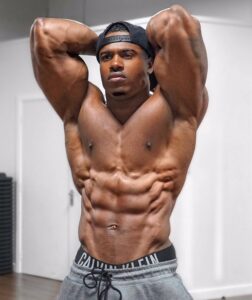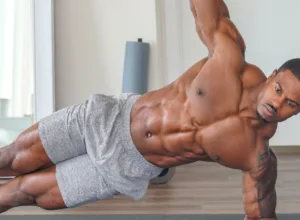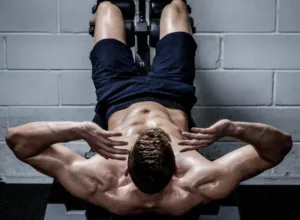Let’s be honest, the dream of ripped six-pack abs is a popular one. Magazine covers and social media flaunt them, making it seem achievable overnight. But the truth is, getting a shredded midsection takes dedication, consistency, and a healthy approach.
Whether you’re aiming to achieve your all-time desired fitness goals or simply want to look perfect in a swimsuit, acquiring a sculpted set of six-pack abs is a goal shared by many. Having ripped six-pack abs is an aim for both men and women and if you’re trying to achieve it, then let us help you with some training and nutritional tips to back you back.
Getting a six-pack requires dedication, hard work, and sacrifice, but you don’t have to hit the gym seven days a week or become a professional bodybuilder to do so.
Instead, a few modifications to your diet and lifestyle can be enough to produce serious, long-lasting results.
Here, we’ll explore the best ways to achieve a defined core, while debunking some myths about “quick fixes.”
Building a Foundation: Diet is King
While exercise plays a crucial role, abs won’t magically appear through crunches alone. You need to shed overall body fat to reveal the underlying abdominal muscles. This requires a healthy diet that focuses on:
- Lean Protein: Protein is the building block of muscle. Aim for 0.8-1 gram of protein per pound of bodyweight daily. Sources include chicken, fish, beans, lentils, and tofu.
- Complex Carbohydrates: These provide sustained energy and prevent blood sugar crashes. Choose whole grains, brown rice, sweet potatoes, and quinoa.
- Healthy Fats: Don’t fear fat! Healthy fats like avocado, nuts, seeds, and olive oil aid in nutrient absorption and hormone regulation.
- Fiber: Fiber keeps you feeling fuller for longer, aiding in portion control. Fruits, vegetables, and whole grains are excellent sources.
- Hydration: Water is vital for overall health and flushes out toxins. Aim for at least eight glasses per day.
Exercise Strategies for a Sculpted Core:
- Compound Lifts: These exercises engage multiple muscle groups at once, burning more calories and promoting overall strength. Squats, deadlifts, lunges, and rows are excellent options.
- Targeted Core Workouts: Don’t neglect exercises that directly target your abs. Include variations of crunches, planks, leg raises, and Russian twists in your routine.
- Cardio: Cardio helps burn overall body fat, revealing your defined abs. High-Intensity Interval Training (HIIT) is a time-efficient option that alternates between intense bursts of activity and recovery periods.
- Progressive Overload: Gradually increase the weight, reps, or sets of your exercises as you get stronger. This challenges your muscles and promotes continued growth.

 Here are some simple ways to achieve six-pack abs quickly and safely:
Here are some simple ways to achieve six-pack abs quickly and safely:
Studies show that cardio exercise can reduce belly fat, which can help you get six-pack abs. One review found that the more cardio people did, the more belly fat they lost.
Exercising the muscles that make up your abdomen can help increase muscle mass to achieve six-pack abs. Pair abdominal exercises with a healthy diet and cardio to optimize results.
Protein may help reduce calorie intake, as well as decrease body weight and fat. It can also help repair and rebuild muscle tissues and preserve muscle mass during weight loss.
High-intensity interval training can help increase fat burning and may be especially useful for reducing belly fat and achieving six-pack abs.
Studies show that drinking water can temporarily increase metabolism, reduce appetite and increase weight loss to help you lose stubborn belly fat.
Processed foods are high in calories, carbs, fat and sodium. These foods require less energy to digest and are also lacking in important nutrients like protein and fiber that can aid in weight loss.
Refined carbs are low in nutrients and can increase hunger levels. A high intake of refined grains has been linked to increased belly fat.
Eating fiber can help keep you feeling full and may help protect against weight gain and fat accumulation.
Powerful shoulders.
Mean-looking triceps.
Big Biceps.
These are the muscles that are easy to focus – sometimes overfocus – on when training. Making them stronger improves your functional fitness and appearance desirable, whether your goal is a couple of steps up in strength or a dramatic shift in body composition – but it is important not to neglect the core: the abdominal muscles.
Some individuals have phenomenal upper body strength, and sport impressive muscular anatomy… but they carry a thick layer of fat over their stomach.
To get an impressive set of 6-ripped six packs abs should they:
a. Train their abs harder?
b. Train their abs more often?
c. Take more supplements?
d. All of the above and then some?
There’s no option “e.”, but if there were, it would say “None of the above.”
The Secret to Ripped Six Pack Abs, Revealed!
Let’s K.I.S.S. – Keep It Simple, Stupid (or, “Silly,” if you prefer):
1. Reduce your adiposity – your body fat intake.
2. Train your abdominal muscles, which may, or may not, even be necessary.
What, that’s it?
Well, in essence, the magical secret, kept behind the locked gates which you thought could only be opened with expensive abdominal exercisers, 200-page guides, or secret supplements is to lose fat.
Here’s how it works:
Everyone has six-pack abs. They’re there, whether you believe it or not. The problem is that not everyone’s body composition is such that their abs are actually visible. These muscles don’t need to be created – they need to be revealed. Remember our “strongman” example – powerful upper body, mighty arms, and a layer of soft flab around their midsection? Believe me, Mr. Strongman is packing some serious stomach muscles, but like on a lot of us, they’re hidden under layers of adipose tissue. That’s why they’re not visible.
Reveal the Six Pack!

Check Out Our List Of The Best Supplements For Building Muscle, Shredding Muscle, Recovery, And Great Health, and Wellness Products! Purchase ifbnewsfeed.org‘s apparels Here: ifbnewsfeed.org
 Though this might be something you shout as you walk through the doors of your local beer store… it’s really about shedding the fat off blanketing your prodigious abs.
Though this might be something you shout as you walk through the doors of your local beer store… it’s really about shedding the fat off blanketing your prodigious abs.
How?
Two words: Caloric. Deficit.
We’ve discussed caloric deficits before, but in case you missed it, let’s start by recapping how the body requires a certain number of calories to sustain its current weight and activity level. That number varies from person to person and is influenced by metabolism, height, weight, age, and other factors and is referred to as a “maintenance level” of calories.
Consuming more calories than are needed is called a “caloric surplus.” Some of this extra food energy is stored as body fat. Conversely, consuming fewer calories than the body requires is called a “caloric deficit,” and the result, predictably, is a reduction in body fat.
Therefore, reducing your caloric intake facilitates a reduction in adiposity, and subsequently, the abs you never thought you had come out of hiding. Presto, change-o!
By the way, those expensive ab-machines I mentioned earlier? If the goal is a reduction in abdominal fat, please, don’t spend (waste!) your money on them. They are marketed on the premise that “spot reduction” – burning fat from one area of the body – actually works. It doesn’t.
Doing machine-assisted crunches will help develop the abdominal muscles, but without reducing overall body fat levels, that great washboard effect will remain hidden under the flab.
But isn’t it “Crunch Time” now?
Amazingly, exercising the abdominal muscles is far less important than shedding the fat which hides them. Lots of people attain incredible six-packs simply by becoming leaner, though sometimes, compound exercises that recruit lots of muscle fibers (which I’m a big fan of), such as deadlifts or squats, may help improve the appearance of the abdominal muscles.
There are a few cases in which spot training – not reduction, but training – of the abs can be of benefit. Some individuals simply don’t have highly defined abs, even in the absence of excess body fat.
This only means that their abdominals are not properly developed.
But remember – losing body fat is the most important step in getting six-pack abs. If you feel your six-pack could be better defined after becoming sufficiently lean, it won’t take much: simply incorporate roughly ten minutes of the ab exercise of your choice twice weekly after your main weight training workout.

Be Realistic and Listen to Your Body:
- Focus on Progress, Not Perfection: Aim for sustainable changes and celebrate small victories. Don’t get discouraged by setbacks; consistency is key.
- Recovery is Crucial: Schedule rest days to allow your muscles to repair and rebuild. Aim for 7-8 hours of sleep nightly for optimal recovery.
- Listen to Your Body: Pain is a warning sign. If you experience pain during exercise, stop and consult a healthcare professional.
Debunking Myths: There’s No Magic Bullet
- Spot Reduction: Unfortunately, you can’t target fat loss in specific areas. Focus on overall body fat reduction to reveal your abs.
- Ab Machines and Gadgets: While these tools can be used as part of a routine, they’re not a replacement for a well-rounded workout plan and healthy diet.
- Fat Burners and Supplements: A healthy diet offers all the nutrients your body needs. Consult a doctor before considering any supplements.
Embrace the Journey: Building a Sustainable Lifestyle
Getting a six-pack is a journey, not a destination. Focus on developing healthy habits you can maintain for life. Celebrate your progress, enjoy the process, and prioritize overall health and well-being. Remember, a healthy core goes beyond aesthetics; it strengthens your body and improves your overall fitness.
More About Sculpting a Six-Pack Contents
- “The Best Hanging Leg Raise Alternative Exercises” For Core Strength And Abs Developments
- This “5-Minute Abs Workout” Will Torch Your Core In The Best Way Possible. Try It
- A Top Celebrity Trainer Shared “4 of His All-Time Favorite Abs Exercises”

- Hormone Replacement Therapy regimen For Men and women
- Hormone Blood Testing for Men (Bodybuilder Blood Testing)
- Shop Optimum Nutrition Energy: Anytime & Pre-Workout








